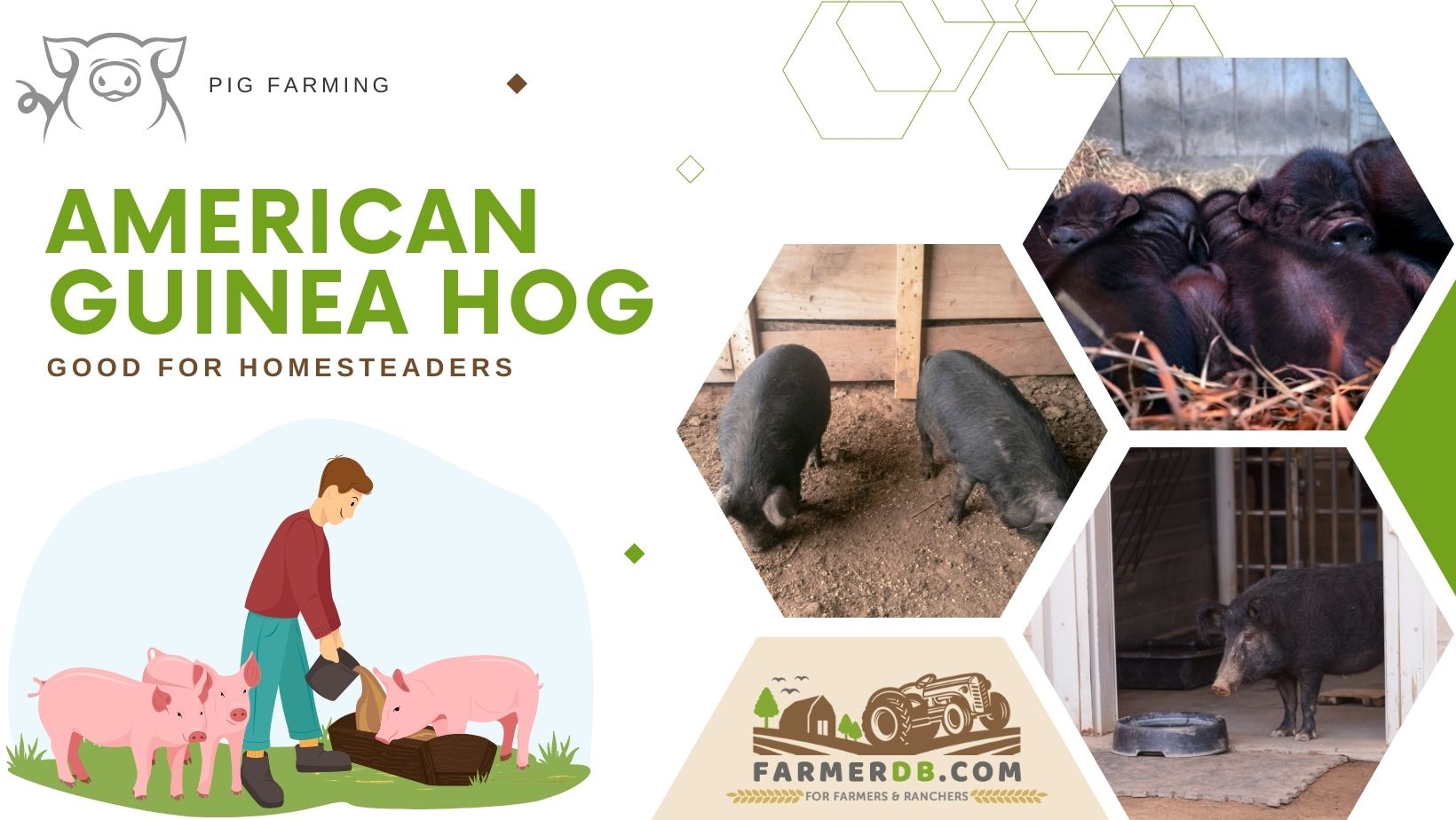
The history of the American Guinea Hog is not entirely clear, but there is evidence that helps draw some conclusions.
Historical evidence indicates that the American Guinea Hog originated in the United States in 1811. After 1840, it was crossbred with the now-extinct “Improved Essex,” a solid black pig from Essex County, England. Historical documents suggest that Essex pigs were imported to Georgia and bred with local southern pigs, resulting in the American Essex breed.
Throughout history, their name has been confused, even by scientists, with another guinea hog variety, a red one brought by sailors from South America. However, the American Guinea Hog discovered in the United States by 1811 seems to have no significant connection to the Red Guineas.
Also known as the yard pig, Guinea Hog, Guinea Forest Hog, or poor man’s pig, this pig breed officially received the name American Guinea Hog in 2006.
Contents
What is an American Guinea Hog?
The American Guinea Hog is a domestic heritage pig breed and is considered one of the smallest breeds, along with Kunekune and Vietnamese Pot-bellied pigs.
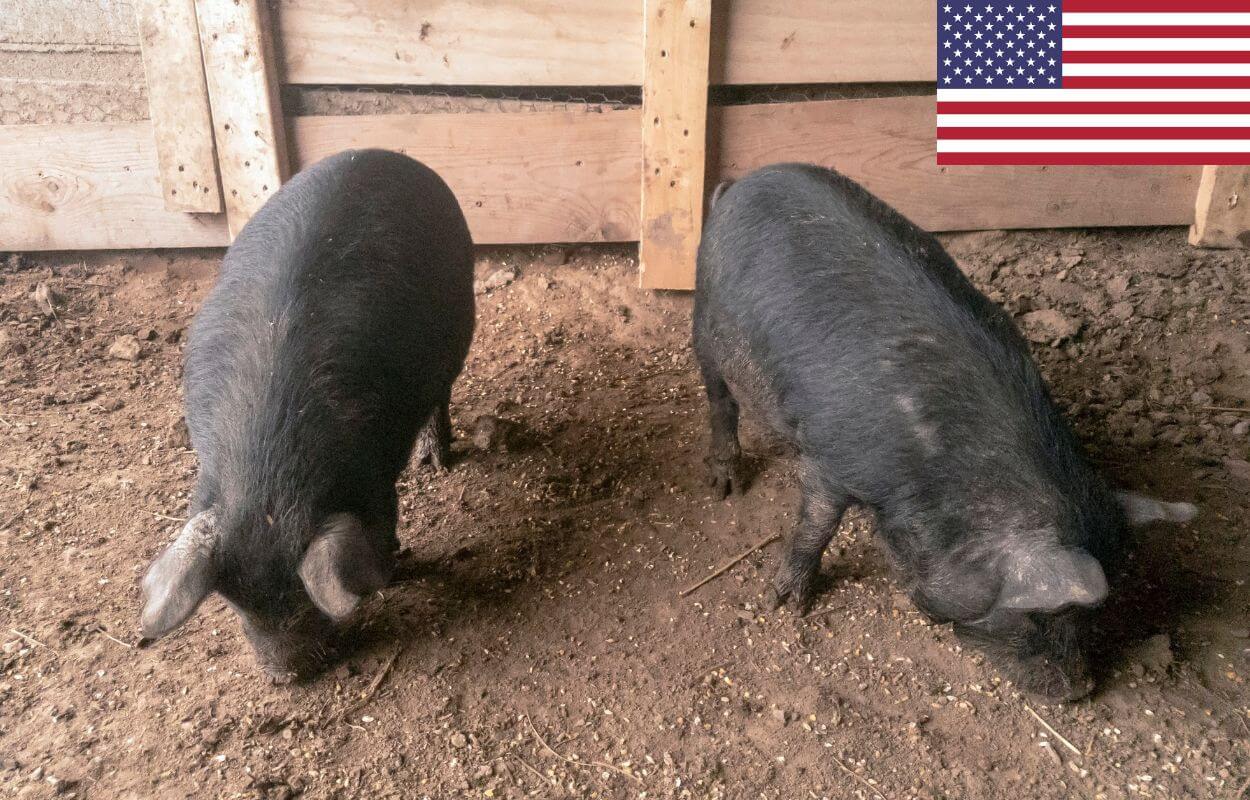
It is listed as a threatened breed on the Livestock Conservancy’s list.
American Guinea Hog Characteristics
American Guinea Hog’s physical characteristics are quite unique and can be easily spotted on a pasture. Let’s look at each one of them.
Physical Characteristics
Size

The size of the American Guinea Hog is small to medium, with adult males or boars measuring 40 to 50 inches (100 – 130 cm) in length from snout to tail and 24 to 26 inches (60 – 66 cm) in shoulder height.
Adult female American Guinea Hogs, or sows, have a length of 36 to 46 inches and a shoulder height of approximately 22 to 24 inches (55-60cm).
The female American Guinea Hog is slightly smaller than the male.
Color and Hair
The American Guinea Hogs’ color is solid black, with some of these pigs having white markings on their faces or feet.
The black hair is short, coarse, and bristly in texture, covering the entire body of the pig.
Head and Face
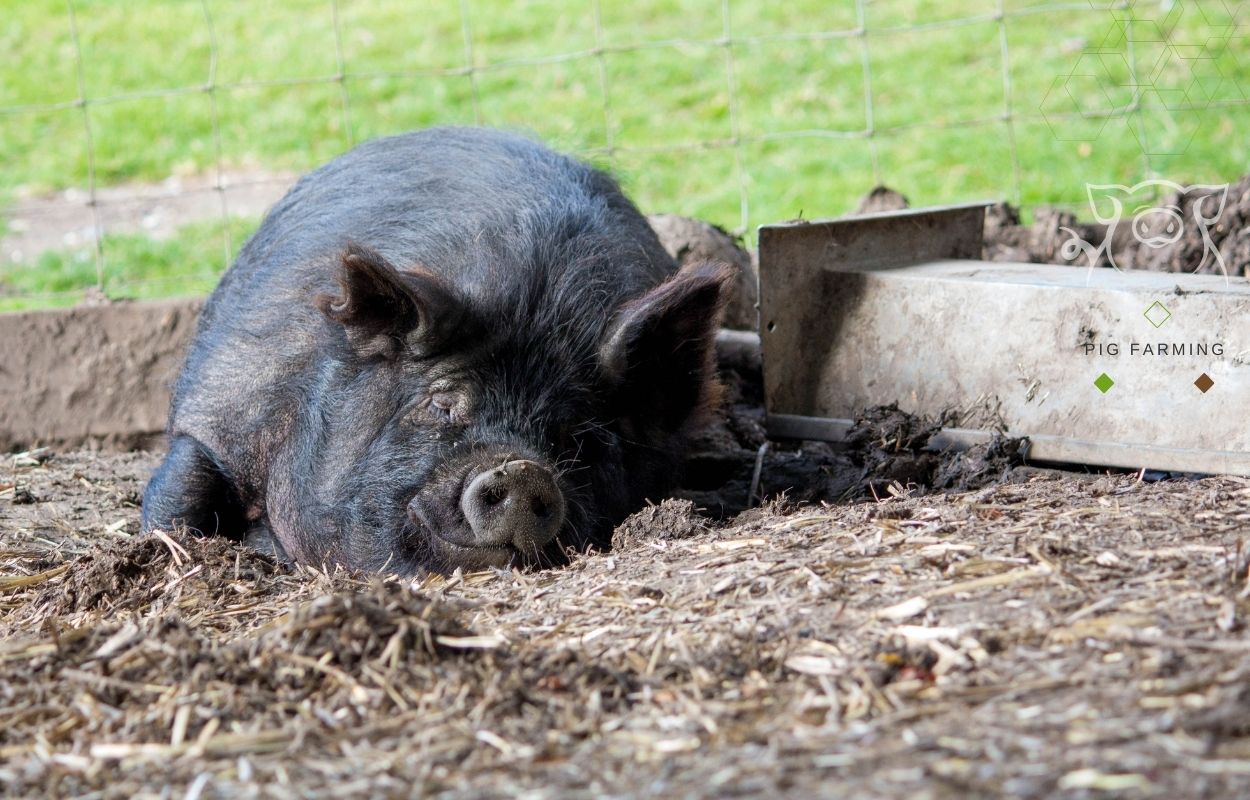
The head of this pig is large but proportionate to the rest of the body. Its face is slightly dished with a concave facial profile, a straight snout, and two small eyes set a bit inward.
Ears
The ears of the American Guinea Hog are small to medium in size and pointy.
The ears do not cover or limit the pig’s visibility.
Body
The body of the American Guinea Hog has a rectangular shape with a straight, slightly arched back. The body is solid, compact, with a round belly that protrudes outward from the body.
Legs and Hooves
The legs of this pig are short, sturdy, and strong, providing both stability and strength. The hooves are also strong, helping the pig in activities such as rooting and foraging.
Teeth
The American Guinea Hog has 44 teeth, including incisors for biting and premolars and molars for chewing. These pigs also have tusks, which are more prominent in males than females.
Tail
The tail of the American Guinea Hog is of medium size and has a single curl.
Lifespan
American Guinea Hogs can live up to 12 to 16 years.
Sows can live up to 14-15 years, while boars can also live up to 16 years.
The longest documented lifespan of an American Guinea Hog boar was 22 years, observed in a zoo setting.
Overall, the American Guinea Hog has a relatively long lifespan compared to other pig breeds, placing it among the list of pigs with extended lifespans.
Growth Rate
The American Guinea Hog has one of the slowest growth rates compared to other miniature pigs.
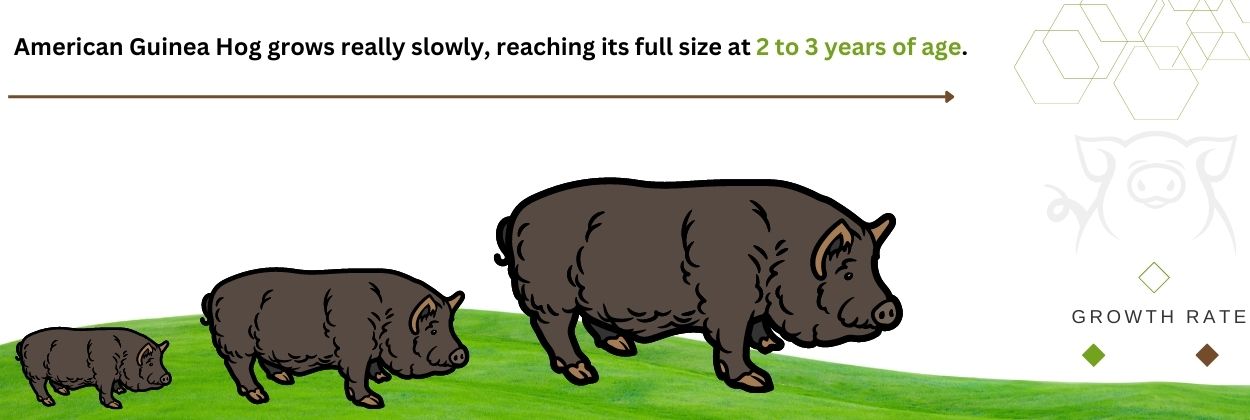
How fast do American Guinea Hogs grow?
American Guinea Hog grows really slowly, reaching its full size at 2 to 3 years of age. It reaches sexual maturity faster at around 8 to 10 months of age.
Still, age strongly depends on genetics, nutrition and diet, management, and environment.
Weight
The American Guinea Hog’s weight is between 150 to 300 lbs (68-136 kg), with sows typically weighing 150 to 180 lbs (68-80 kg) and boars weighing 250 to 300 lbs (110-135 kg).
Below, you can find an American Guinea Hog growth chart for more information:
| Age | Weight (lbs / kg) |
|---|---|
| 1 day | 1 lb / 0.5 kg |
| 5 weeks | 5 to 6 lbs / 2.2 – 2.7 kg |
| 8 weeks | 9 to 10 lbs / 4 – 4.5 kg |
| 6-7 months | 60 lbs / 27 kg |
| 2-3 years | 150-180 lbs (sow) / 68-80 kg 250-300 lbs (boar) / 110-135 kg |
Slaughter Time
The American Guinea Hog can be butchered at one year of age.
At one year old, this pig weighs around 110 to 120 lbs (50-55 kg), which is the best weight for butchering an American Guinea Hog as it provides approximately 50 to 60 lbs (23-27 kg) of pork.
The pig’s age for butchering can vary depending on the pig farmer’s preferences. While these pigs grow slowly, it is possible to butcher them at a younger age for a smaller carcass weight.
For instance, if a farmer chooses to ration the feed, they can opt to butcher the pigs at 6-7 months when they reach a weight of 60 lbs (27 kg), resulting in approximately 20 to 30 lbs (9-13 kg) of pork.
Temperament and Behaviour
The American Guinea Hog has a good temperament and overall behavior. They are easy to handle due to their friendly and docile attitude. They are known for being one of the friendliest pig breeds and for their ability to develop a unique bond with their caregivers.
These pigs are capable of living and coexisting with other farm animals, as they enjoy playing and having fun. Aggression is not a typical part of their behavior. Even when they are hungry and ready to be fed, their excitement can be easily managed by the caregiver due to their small size.
Regarding behavior, American Guinea Hogs exhibit natural rooting, grazing, and foraging behaviors, which help them explore and understand their environment. They are curious animals and often show interest in new objects or situations.
They also possess good intelligence and can learn commands and routines if trained from a young age.
Meat
American Guinea Hogs are good to eat.
The meat of the American Guinea Hog is great, offering a well-balanced ratio of lean meat and fat. It contains essential vitamins such as vitamin B12, niacin (vitamin B3), thiamin (vitamin B1), and vitamin B6, as well as minerals like iron, zinc, selenium, and phosphorus.
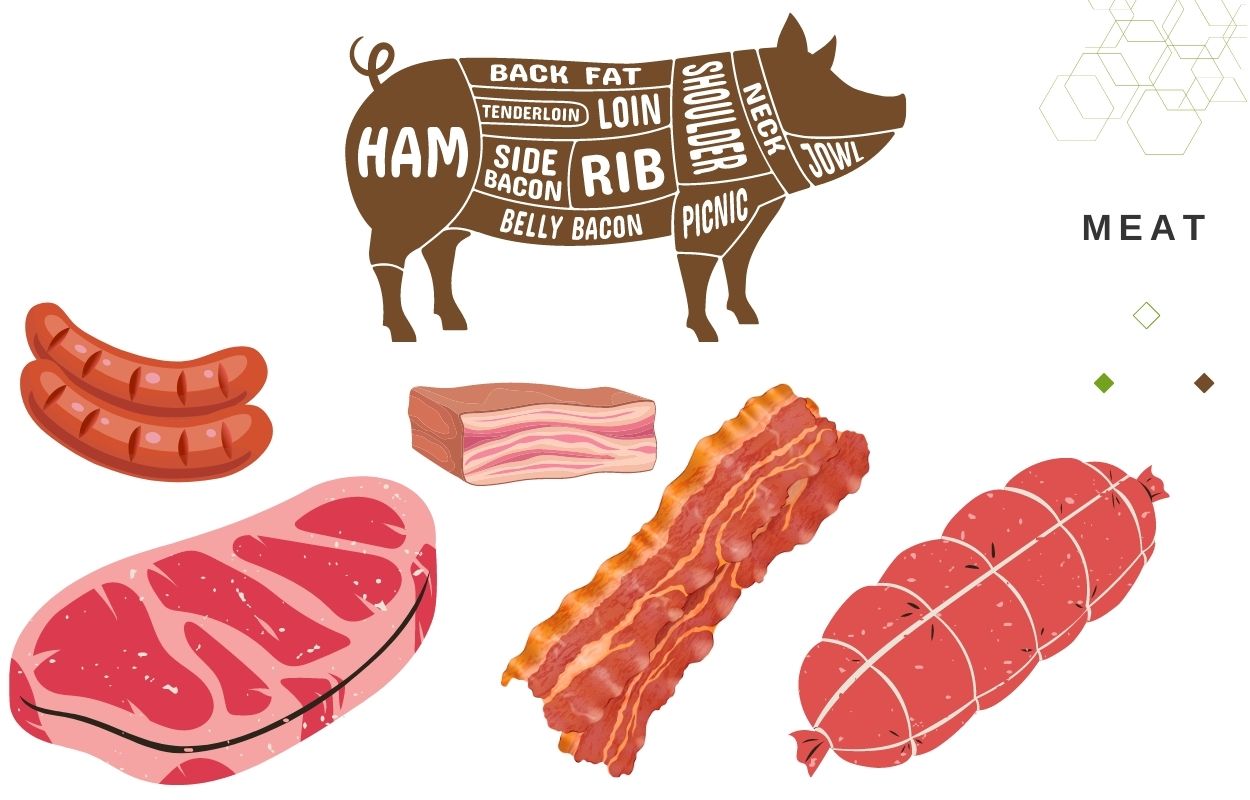
If not allowed to fatten excessively, the meat is well-marbled, with a creamy fat that melts in your mouth. The part with lean meat has a deep, rich flavor that comes from their natural diet and slow growth period. Combined with the soft and delicious fat, the meat has a juicy and tender texture that is not overly chewy.
If allowed to fatten, the American Guinea Hog will accumulate more fat than lean meat, transforming into a pig that is ideal for producing lard. When slaughtered, they yield a significant amount of flavorful fat.
This pig is also well-suited for traditional cuisines and is great for producing charcuterie. From the meat of the American Guinea Hog, you can make bacon, ham, sausages, and other meat products. While bacon is a popular choice, many also enjoy the fresh cuts by baking or grilling them.
Raising American Guinea Hog
Due to their friendly temperament and small stature, raising American Guinea Hogs is one of the easiest activities for a pig farmer to enjoy.
Feeding
American Guinea Hogs have natural instincts for grazing and rooting, which helps them find their own food. When left free on a pasture, they will consume soil goodies such as worms, bugs, insects, fresh grass, herbs, and other plants if planted by the farmer.
While they are capable of grazing, even on high-quality pastures with abundant vegetation, American Guinea Hogs cannot thrive on that alone, and they require supplemental feed.
During the warm season, in addition to what they graze and root, American Guinea Hogs can be fed grains, legumes, fruits, dairy, and non-sweet, non-salty, and non-moldy kitchen scraps.
In the cold season, American Guinea Hogs can be fed grains and even hay. Legumes and fruits can also be added if available, similar to the warm season.
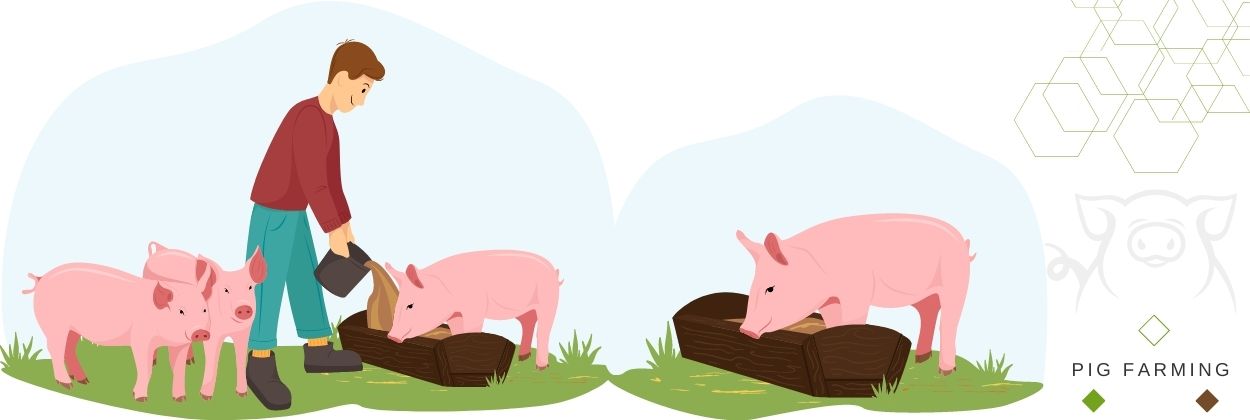
As a pig farmer, it’s important to be prepared for the appetite of American Guinea Hogs. They eat 4% of their live weight daily. For example, a 150 lbs (68 kg) pig will require approximately 5 to 6 lbs (2.7 kg) of feed intake per day for proper development.
This is a substantial amount of feed, especially if they are not allowed to graze as well.
The specific feeding routine can depend on the pig farmer’s preferences or the farm’s schedule. The entire portion of feed can be given once per day or split into two meals, one in the morning and one in the evening.
It’s essential to closely monitor the amount of feed provided as American Guinea Hogs can gain weight rapidly if overfed.
Water
An American Guinea Hog requires 3 to 5 gallons (11-19 liters) of fresh water daily, while a lactating sow needs 7 gallons (26 liters) per day. With such a high water intake, you need a good water system in your pig farm.
Environment
These Hogs thrive when raised in ample pastures or foraging areas. Access to such an environment allows them to exercise their natural instincts for grazing and rooting, helping them meet their dietary needs.
When raised on pasture, it is important to have a strong electric fence to contain the pigs within the designated area and protect them from potential predators.
If raising American Guinea Hogs without access to pasture is necessary, they can adapt to closed systems such as indoor housing or pig pens. Piglets generally adjust quickly to these environments
If you need to transition a pig that has previously lived in a pasture to a closed system, it is best to do so gradually.
I recommend allowing the pig to adjust step by step to the new environment to minimize stress and potential health issues. Abrupt changes can cause stress, but given time, the pig will adjust and continue to thrive even in a closed environment.
How many American Guinea Hogs per acre?
You can raise one American Guinea Hog per acre, but if you practice rotational grazing, you can raise 5 to 7 hogs per acre.
Climate
The ideal climate for American Guinea Hogs is a moderate one with mild winters. However, they are adaptable and can be raised in various climates as long as they are provided with good conditions.
They have a good tolerance for hot temperatures as long as they have access to shade or a wallow, and they can also handle lower temperatures well if they have suitable shelter and bedding.
Shelter
American Guinea Hogs require shelter, particularly in colder climates with harsh winters. Despite their thick layer of fat and dense coats of hair, they need shelter to protect them from rain, snow, and wind.
In addition to shelter, they also need straw bedding to keep them extra warm.
Breeding
American Guinea Hogs can be bred starting at the age of 8 to 10 months.
The gestation period for American Guinea Hogs is 112 to 155 days, or 3 months, 3 weeks, and 3 days.
These pigs generally have a litter size of 6 to 10 piglets, with an average of 8. These litters typically demonstrate good survivability.
American Guinea Hogs are known for their excellent mothering skills. The sows are attentive and protective mothers with strong nurturing instincts toward their piglets. They are highly dedicated to caring for their young, providing warmth, milk, and guidance as the piglets grow.
The breeding of American Guinea Hogs can be done naturally or through artificial insemination.
Breeding American Guinea Hogs naturally involves allowing the hogs to mate and reproduce without artificial intervention.
Here are some key steps to consider when breeding American Guinea Hogs naturally:
- Choose a healthy gilt or sow and boar, ensuring that they meet the desired breed standards.
- Closely monitor the sow or gilt for signs of heat, including a swollen vulva, increased restlessness, and agitated behavior.
- Once the sow/gilt is in heat, introduce her to the boar in a controlled environment such as a breeding pen or pasture, and allow them time to interact with each other.
- Monitor the mating process to ensure successful breeding.
- During the gestation period, continue to monitor the pregnant sow’s health and provide appropriate care.
If you choose to breed through artificial insemination, you will need to acquire or collect boar semen.
Once again, closely monitor the sow for signs of heat. When the sow is in heat, administer the semen to facilitate fertilization.
Health Issues
The most common health issues of the American Guinea Hog include:
- Obesity
- Fertility issues caused by excessive weight
- Respiratory issues, such as pneumonia
Vaccination
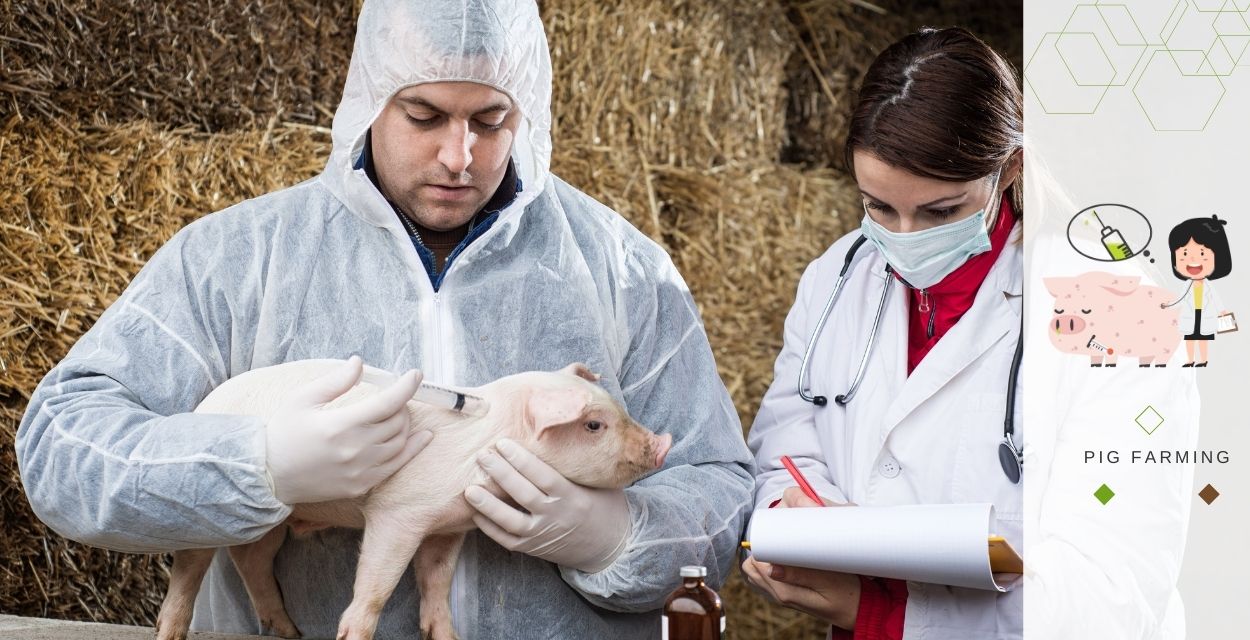
American Guinea Hogs require vaccinations to minimize the risk of common pig diseases. Vaccines recommended for them include the Swine Flu vaccine, PCV2 vaccine, Mycoplasma vaccine, Parvovirus vaccine, Leptospirosis vaccine, and Erysipelas vaccine.
Following the standard pig vaccination chart is important for their overall health and disease prevention.
Should you raise American Guinea Hogs?
Profitability
American Guinea Hogs is not the pig breed to choose if you’re looking to create a business, especially as the primary pig breed on your farm.
These pigs have a slow growth rate, require significant amounts of supplemental feed, and their meat yield is relatively small due to their miniature size.
Plus, the price of an American Guinea Hog is from $350 to $400. While they may serve as a secondary pig breed to help offset other farm expenses, the profitability may not be substantial.
It may be better to consider other pasture-raised pig breeds such as the Black Iberian Pig or Hereford pig if you’re aiming to establish a profitable business.
Personal Use
The American Guinea Hog is a suitable pig breed for homesteaders looking for a friendly and easy-to-handle pig.
Despite yielding a smaller quantity of meat compared to other pig breeds, it offers a unique and distinct taste. What’s great is that you can also use them as a source of lard by fattening them.
Raising these hogs is beneficial for homesteaders due to their small size, which makes them easier to handle compared to larger breeds.
By raising this breed, you also contribute to the preservation and survival of the American Guinea Hog breed.
Advantages and Disadvantages
Just like any other pig breed, the American Guinea Hog has its own advantages and disadvantages:
| Pros | Cons |
|---|---|
| Adaptability to various climates | Slow growth rate |
| Good foraging and grazing instincts | Can be prone to obesity if overfed |
| Good temperament and friendly disposition | Limited availability |
| Well-marbled and flavorful meat | Require lots of supplemental feed |
| Great mothering skills | Limited commercial demand |
| Hardy and resilient breed | |
| Piglets have a good survival rate | |
| Can be raised in various management systems |
Bibliography:
– Saving the Guinea Hogs: The Recovery of an American Homestead Breed by Cathy R Payne
– AGHA American Guinea Hog Association / https://guineahogs.org


